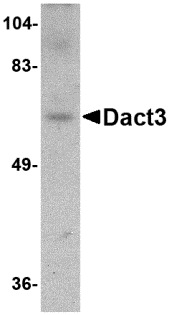Catalog#:4871
The Wnt signaling cascade is a conserved process in multicellular animals that plays important roles during development and can contribute to cancer and other diseases. Many members of this pathway are also expressed in the postnatal tissues such as brain. One such protein is Dact3, a member of the Dact protein family that was initially identified through binding to Disheveled (Dvl), a cytoplasmic protein essential to Wnt signaling. Dact3 is expressed in the ventral region of maturing somites, limb bud and branchial arch mesenchyme, embryonic CNS, and the adult brain. Recent evidence shows that Dact3 acts as a negative regulator Wnt/b-catenin signaling that is repressed at the transcriptional level in colorectal cancer and this repression is associated with bivalent histone modifications. This repression can be reversed by pharmacological agents that targets both histone methylation and deacetylation, suggesting that Dact3 may be a potential target for therapeutic treatment of this cancer. At least three isoforms of Dact3 are known to exist.
Additional Names: Dact3, Dapper homolog 3, Dapper antagonist of beta-catenin 3, RRR3

Description
Left: Western blot analysis of Dact3 in rat brain tissue lysate with Dact3 antibody at 1 µg/ml.
Source:Dact3 antibody was raised against a 17 amino acid peptide from near the amino terminus of human Dact3.
Purification: Affinity chromatography purified via peptide column
Clonality and Clone: This is a polyclonal antibody.
Host: Dact3 antibody was raised in rabbit.
Please use anti-rabbit secondary antibodies.
Application: Dact3 antibody can be used for detection of Dact3 by Western blot at 1 – 2 µg/ml.
Tested Application(s): E, WB
Buffer: Antibody is supplied in PBS containing 0.02% sodium azide.
Blocking Peptide:Cat.No. 4871P - Dact3 Peptide
Long-Term Storage: Dact3 antibody can be stored at 4ºC, stable for one year. As with all antibodies care should be taken to avoid repeated freeze thaw cycles. Antibodies should not be exposed to prolonged high temperatures.
Positive Control:
1.Cat. No. 1463 - Rat Brain Tissue Lysate
Species Reactivity: H, M, R
GI Number: 119368655
Accession Number: Q96B18
Short Description: Dapper homolog 3
References
1. Shimigori T, VanSant J, Paik E, et al. Members of the Wnt, Fz, and Frp gene families expressed in postnatal mouse cerebral cortex. J. Comp. Neurol. 2004; 473:496-510.
2. Cheyette BNR, Waxman JS, Miller JR, et al. Dapper, a Dishevelled-associated antagonist of beta-catenin and JNK signaling, is required for notochord formation. Dev. Cell 2002; 2:449-61.
3. Katoh M and Katoh M. Identification and characterization of human DAPPER1 and DAPPER2 genes in silico. Int. J. Oncol. 22:907-13.
4. Fisher DA, Kivimae S, Hoshino J, et al. Three Dact gene family members are expressed during embryonic development and in the adult brains of mice. Dev. Dyn. 2006; 235:2620-30.

Description
Left: Western blot analysis of Dact3 in rat brain tissue lysate with Dact3 antibody at 1 µg/ml.
Source:Dact3 antibody was raised against a 17 amino acid peptide from near the amino terminus of human Dact3.
Purification: Affinity chromatography purified via peptide column
Clonality and Clone: This is a polyclonal antibody.
Host: Dact3 antibody was raised in rabbit.
Please use anti-rabbit secondary antibodies.
Application: Dact3 antibody can be used for detection of Dact3 by Western blot at 1 – 2 µg/ml.
Tested Application(s): E, WB
Buffer: Antibody is supplied in PBS containing 0.02% sodium azide.
Blocking Peptide:Cat.No. 4871P - Dact3 Peptide
Long-Term Storage: Dact3 antibody can be stored at 4ºC, stable for one year. As with all antibodies care should be taken to avoid repeated freeze thaw cycles. Antibodies should not be exposed to prolonged high temperatures.
Positive Control:
1.Cat. No. 1463 - Rat Brain Tissue Lysate
Species Reactivity: H, M, R
GI Number: 119368655
Accession Number: Q96B18
Short Description: Dapper homolog 3
References
1. Shimigori T, VanSant J, Paik E, et al. Members of the Wnt, Fz, and Frp gene families expressed in postnatal mouse cerebral cortex. J. Comp. Neurol. 2004; 473:496-510.
2. Cheyette BNR, Waxman JS, Miller JR, et al. Dapper, a Dishevelled-associated antagonist of beta-catenin and JNK signaling, is required for notochord formation. Dev. Cell 2002; 2:449-61.
3. Katoh M and Katoh M. Identification and characterization of human DAPPER1 and DAPPER2 genes in silico. Int. J. Oncol. 22:907-13.
4. Fisher DA, Kivimae S, Hoshino J, et al. Three Dact gene family members are expressed during embryonic development and in the adult brains of mice. Dev. Dyn. 2006; 235:2620-30.

No comments:
Post a Comment